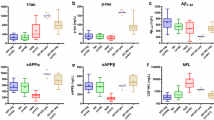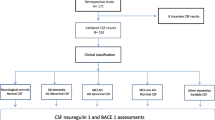Abstract
The potential role of microbiological factors such as Chlamydia pneumoniae (ChP) in the pathogenesis of neurodegenerative disorders, including Alzheimer’s disease (AD) and vascular dementia (VD), has been suggested, but the correctness of this hypothesis still needs to be tested. In this study the appearance of ChP in the cerebrospinal fluid (CSF) of 57 AD and 21 VD patients and in 47 controls (CG) as well as the influence of ChP on the levels of tau protein and Aβ42 were investigated. The frequency of ChP occurrence in the AD patient group (43.9%) was significantly higher (p < 0.001) than in the control group (10.6%). In the case of VD patients, 9.5% of this group was positive for ChP. The presence of ChP DNA in the CSF of patients with AD significantly increases the occurrence of this disease (odds ratio = 7.21). Cerebrospinal fluid Aβ42 levels were significantly lower in patients with AD than in the CG (p < 0.001). Cerebrospinal tau protein was significantly higher in AD vs. CG (p = 0.007). However, no relationships between the presence of the bacterium in CSF and the level of either tau or Aβ42 protein were observed. In conclusion, we may suspect that testing for the presence of ChP in CSF, along with the tau and Aβ42 markers, may be used in the clinic diagnosis of AD.
Similar content being viewed by others
References
Andreasen N, Hesse C, Davidsson P, et al. (1999) Cerebrospinal fluid b-Amyloid 1-42 in Alzheimer Disease: differences between early-and late-onset Alzheimer disease and stability during the course of disease. Arch Neurol 56:673–680
Andreasen N, Minnthon L, Davidsson P, et al. (2001) Evaluation CSF-tau and CSF-Abeta42 as diagnostic markers for Alzheimer disease in clinical practice. Arch Neurol 58:373–379
Balin BJ, Gerard HC, Arking EJ, et al. (1998) Identification and localization of Chlamydia pneumoniae in the Alzheimer’s brain. Med Microbiol Immunol 187:23–42
Bauer J, Ganter U, Strauss SS, et al. (1992) The participation of interleukin-6 in the pathogenesis of Alzheimer’s disease. Res Immunol 143:650–657
Blasi F, Centanni S, Allegra L. (2004) Chlamydia pneumoniae: crossing the barriers? Eur Respir J 23:499–500
Dechend R, Maass M, Gieffer J, et al. (1999) Chlamydia pneumoniae infection of vascular smooth muscle and endothelial cells activates NF-kappaB and induces tissue factor and PAI-1 expression: a potential link to accelerated arteriosclerosis. Circulation 100:1369–1373
Galasko D, Clark C, Motter R, et al. (1998) High cerebrospinal fluid tau and low amyloid ß42 levels in the clinical diagnosis of Alzheimer disease and relation to apolipoprotein E genotype. Arch Neurol 55:937–945
Gaydos CA, Quinn TC, Eiden JJ. (1992) Identification of Chlamydia pneumoniae by DNA amplification of the 16S rRNA gene. J Clin Microbiol 30:796–800
Gieffers J, Pohl D, Treib J, et al. (2001) Presence of Chlamydia pneumoniae DNA in the cerebral spinal fluid is a common phenomenon in a variety of neurological diseases and not restricted to multiple sclerosis. Ann Neurol 49:585–589
Gieffers J, Reusche E, Solbach W, et al. (2000) Failure to detect Chlamydia pneumoniae in brain sections of Alzheimer’s disease patients. J Clin Microbiol 38:881–882
Gieffers J, van Zandbergen G, Rupp J, et al. (2004) Phagocytes transmit Chlamydia pneumoniae from the lung to the vasculature. Eur Respir J 23:506–510
Grimaldi LM, Pincherle A, Martinelli-Boneschi F, et al. (2003) An MRI study of Chlamydia pneumoniae in Italian multiple sclerosis patients. Mult Scler 9:467–471
Itzhaki RF, Dobson CB, Lin WR, et al. (2001) Association of HSV-1 and apolipoprotein E-verepsilon4 in Alzheimer’s disease. J Neurovirol 6:570–571
Itzhaki RF, Lin WR, Shang D, et al. (1997) Herpes simplex virus type 1 in brain and risk of Alzheimer’s disease. Lancet 349:241–244
Itzhaki RF, Wozniak MA, Appelt DM, et al. (2004) Infiltration of the brain by pathogens causes Alzheimer’s disease. Neurobiol Aging 25:619–627
Jamieson GA, Maitland NJ, Wilcock GK, et al.( 1991) Latent herpes simplex virus type 1 in normal and Alzheimer’s disease brains. J Med Virol 33:224–227
Kapaki E, Paraskevas GP, Zalonis I, et al. (2003) CSF tau protein and β-amyloid (1-42) in Alzheimer’s disease diagnosis: discrimination from normal ageing and other dementias in the Greek population. Eur J Neurol 10:119–128
Lin WR, Wozniak MA, Wilcock GK, et al. (2002) Cytomegalovirus is present in a very high proportion of brains from vascular dementia patients. Neurobiol Dis 9:82–87
Little CS, Hammond CJ, MacIntyre A, et al. (2004) Chlamydia pneumoniae induces Alzheimer-like amyloid plaque brains of BALB/c mice. Neurobiol Aging 25:419–429
Loeb MB, Molloy DW, Smieja M, et al. (2004) A Randomized, Controlled Trial of Doxycycline and Rifampin for Patients with Alzheimer’s Disease. J Am Geriatr Soc 52:381–387
MacIntyre A, Abramov R, Hammond CJ, et al. (2003) Chlamydia pneumoniae infection promotes the transmigration of monocytes through human brain endothelial cells. J Neurosci Res 71:740–750
Maddalena A, Papassotiropoulos A, Muller-Tillmanns B, et al. (2003) Biochemical diagnosis of Alzheimer disease by measuring the cerebrospinal fluid ratio of phosphorylated tau protein to b-amyloid peptide 42. Arch Neurol 60:1202–1206
Maass M, Bartels C, Engel P, et al. (1998) Endovascular presence of viable Chlamydia pneumoniae is a common phenomenon in coronary artery disease. J Am Coll Cardiol 31:827–832
Neumann FJ (2002) Chlamydia pneumoniae-atherosclerosis link: a sound concept in search for clinical relevance. Circulation 106:2414–2416
O’Brien MD (1988) Vascular dementia is underdiagnosed. Arch Neurol 45:797–798
Ring RH, Lyons JM. (2000) Failure to detect Chlamydia pneumoniae in the late-onset Alzheimer’s brain. J Clin Microbiol 38:2591–2594
Sadowski M, Pankiewicz J, Scholtzova H, et al. (2004) Links Between the Pathology of Alzheimer’s Disease and Vascular Dementia. Neurochemical Research 29:257–1266
Sjögren M, Vanderstichele H, Agren H, et al. (2001) Tau and Aβ in cerebrospinal fluid from healthy adults 21–93 years of age: establishment of reference values. Clin Chem 47:1776–1781
Sunderland T, Linker G, Mirza N, et al. (2003) Decreased beta-amyloid1–42 and increased tau levels in cerebrospinal fluid of patients with Alzheimer disease. JAMA 289:2094–2103
Taylor GS, Vipond IB, Paul LD, et al. (2002) Failure to correlate C. pneumoniae with late onset Alzheimer’s disease. Neurology 59:142–143
Walsh PS, Metzger DA, Higuchi R. (1991) Chelex 100 as a medium for simple extraction of DNA for PCR-based typing from forensic material. Biotechniques 10:506–513
Ward ME (1999) Mechanisms of chlamydia-induced disease. In: . Stephens RS, eds. Chlamydia: Intracellular Biology, Pathogenesis, and Immunity, Washington D.C., ASM press, pp. 171–210
Wisniewski HM, Wegiel J. (1995) The neuropathology of Alzheimer’s disease. Neuroimaging Clin N Am 5:45–57
Wozniak MA, Cookson A, Wilcock GK, et al. (2003) Absence of Chlamydia pneumoniae in brain of vascular dementia patients. Neurobiol Aging 24:761–765
Yamamoto H, Watanabe T, Miyazaki A, et al. (2005) High prevalence of Chlamydia pneumoniae antibodies and increased high-sensitive C-reactive protein in patients with vascular dementia. J Am Geriatr Soc 53:583–589
Acknowledgements
This work has been supported by grants from the Medical University.
Author information
Authors and Affiliations
Corresponding author
Additional information
Received in revised form: 18 June 2006
Rights and permissions
About this article
Cite this article
Paradowski, B., Jaremko, M., Dobosz, T. et al. Evaluation of CSF-Chlamydia pneumoniae, CSF-tau, and CSF-Abeta42 in Alzheimer’s disease and vascular dementia. J Neurol 254, 154–159 (2007). https://doi.org/10.1007/s00415-006-0298-5
Received:
Accepted:
Published:
Issue Date:
DOI: https://doi.org/10.1007/s00415-006-0298-5




